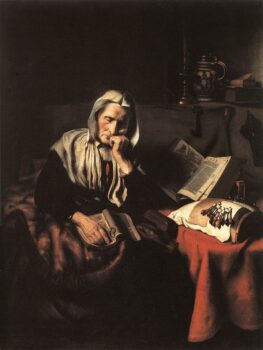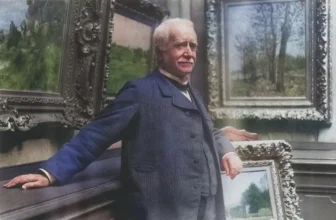Meaning of An Old Woman Dozing Painting Nicolaes Maes
In the quiet corner of a sun dappled room, an elderly woman drifts into slumber, her spectacles slipping down her nose and her hands resting gently over an open book. At first glance, Nicolaes Maes’ painting An Old Woman Dozing appears deceptively simple, a peaceful domestic moment frozen in time. But on closer inspection, this 17th-century masterpiece reveals itself to be a deeply symbolic work rich with meaning, reflecting themes of piety, transience, introspection, and the ordinary dignity of aging.
This post delves into the analysis, background, and interpretation of An Old Woman Dozing, exploring the artist behind the work, its context in art history, and the painting’s lasting impact.
Who Was Nicolaes Maes? The Artist Behind the Canvas
Nicolaes Maes (1634–1693) was a Dutch painter and a student of Rembrandt van Rijn. Born in Dordrecht, Maes trained under Rembrandt in Amsterdam during the early 1650s, absorbing his master’s fascination with dramatic lighting, expressive character studies, and everyday domestic life.
While Maes initially focused on biblical and historical subjects in his early career, he soon shifted toward genre painting, scenes of ordinary people in domestic settings, where he found his true voice. These works often feature women engaged in daily routines: sewing, spinning, reading, watching over children, or, as in this case, napping.
An Old Woman Dozing stands out as one of his most intimate and psychologically resonant genre paintings. Created circa 1656, it epitomizes Maes’ capacity to infuse the mundane with emotional and symbolic depth, establishing him as a key figure in the Dutch Golden Age of painting.
How Was An Old Woman Dozing Painted?
Maes’ artistic technique was heavily influenced by his mentor Rembrandt. His use of chiaroscuro, strong contrasts between light and dark, creates a profound sense of depth and draws the viewer’s eye to key elements of the composition. In An Old Woman Dozing, the central figure is bathed in a warm, natural light that emphasizes the texture of her aging skin, the softness of her garments, and the stillness of the moment.
The painting is rendered in oil on canvas. Maes employed a limited but rich color palette, earth tones, deep reds, browns, and muted yellows, to evoke the warmth of a humble interior space. The brushwork is both detailed and expressive: the folds in the woman’s clothing, the aged wood of the furniture, and the glint on her glasses all showcase Maes’ technical prowess.
What Is Happening in the Painting?
In An Old Woman Dozing, an elderly woman sits alone in a modest, well-lit interior. Her body has relaxed into sleep, her head gently tilted forward. On her lap rests an open Bible, a clear sign of her interrupted reading. The scene is tender and contemplative. A ball of yarn and knitting needles lie nearby, further emphasizing her domesticity.
Next to her is a small table adorned with a book and a candle, both symbolic of enlightenment and the passage of time. The simplicity of the setting invites a quiet introspection in the viewer: there is no grandeur, no opulence, only the sanctity of a life steeped in quiet faith and routine.
Symbolism and Meaning in An Old Woman Dozing
While the painting appears serene and literal, it’s layered with symbolic meaning, a hallmark of Dutch Golden Age art. Here are some of the key symbolic elements present in the work:
1. The Bible
The open Bible on the woman’s lap immediately signals her piety. This is not a woman of idle habits; even in her twilight years, she finds solace in scripture. That she has fallen asleep while reading suggests either the physical toll of age or a metaphorical allusion to spiritual peace.
2. The Candle
Unlit or dimly burning candles in paintings often symbolize the passing of time, the fragility of life, or the soul’s presence. In this painting, the candle beside her likely serves as a memento mori, Latin for “remember you must die.” It’s a gentle reminder of mortality, but not a grim one. Instead, it speaks to the acceptance of aging and the wisdom that comes with it.
3. The Spectacles
Her eyeglasses, which have slipped slightly, may indicate fading eyesight, and by extension, the fading clarity that can come with age. But they are also a symbol of learning and introspection, suggesting that even in advanced years, the pursuit of knowledge and faith continues.
4. Yarn and Knitting
The ball of yarn and knitting needles near her feet are rich in domestic symbolism. They speak to a life of labor, care, and nurturing. Yarn has also historically symbolized the thread of life, especially in classical mythology, think of the Fates spinning and cutting the thread.
5. The Act of Dozing
Sleep, or more precisely dozing, in art often implies a state between consciousness and the unconscious, a liminal space. It can represent spiritual contemplation or even foreshadow the eternal rest of death. But Maes doesn’t seem to cast it in a morbid light. Instead, the doze is peaceful, dignified, and gentle, possibly signifying a life lived in contentment.
What Does An Old Woman Dozing Painting Represent?
An Old Woman Dozing is a quiet meditation on aging, faith, and the rhythms of life. It speaks to the sacredness of ordinary moments and the inner lives of people often overlooked, older women, in particular.
In the 17th-century Dutch Republic, there was a cultural fascination with moralistic messages wrapped in domestic imagery. This painting fits squarely within that context. It serves as a visual sermon on virtue: modesty, industriousness, devotion, and patience. It reminds viewers of the inevitability of aging and the grace with which one might embrace it.
Moreover, the painting reflects a Protestant ethos common in Dutch art of the time. It values simplicity, spiritual introspection, and humility over lavishness and grandeur. This woman is not idle; she is merely resting between acts of devotion and labor. Her surroundings, plain but tidy, suggest a morally upright household.
Genre Painting in the Dutch Golden Age
An Old Woman Dozing is a quintessential example of genre painting, a style that flourished in the Dutch Golden Age. Unlike historical or religious art that depicted grand narratives, genre paintings focused on the ordinary, domestic life, middle-class interiors, market scenes, and moments of daily routine.
Yet, while the subject matter was ordinary, the symbolism and moral undertones were anything but. Artists like Maes elevated everyday life into a space for philosophical and ethical contemplation.
This painting also incorporates elements of portraiture and still life. While not an official portrait, the woman is rendered with a sensitivity that suggests individual character rather than an archetype. Meanwhile, the surrounding objects, Bible, candle, yarn, function as a still life within the scene, imbuing it with deeper meaning.
Where Is the An Old Woman Dozing Painting Located Today?
Today, An Old Woman Dozing resides in the collection of the National Gallery in London, one of the world’s premier institutions for Western European art. It is part of their rich holdings in Dutch Golden Age painting, alongside works by Rembrandt, Vermeer, and others.
Visitors can see the painting in person and witness its quiet charm firsthand. Despite being modest in scale, the painting commands attention through its emotional resonance and painterly grace.
Nicolaes Maes may not enjoy the same household-name recognition as his mentor Rembrandt, but his contributions to Dutch art were significant. He helped shape the direction of genre painting and elevated the dignity of everyday life through his sensitive portrayals of women, children, and domestic spaces.
An Old Woman Dozing is frequently cited in scholarly literature and museum catalogs as an exemplar of Dutch moral painting. It has influenced both academic interpretations of aging in art and contemporary discussions on the representation of women and domesticity.
Art historians have also noted Maes’ influence on later genre painters, including Johannes Vermeer and Pieter de Hooch, who continued to explore themes of domestic virtue and light-filled interiors.
A Poem in Paint
An Old Woman Dozing is a gentle masterpiece, one that speaks in whispers rather than declarations. It asks viewers to pause, to observe, to contemplate the silent truths that reside in everyday life. Through warm light, subtle symbols, and a lovingly rendered figure, Nicolaes Maes invites us into a world where the ordinary becomes sacred, and where sleep is not an escape but a reflection of inner peace.
In our modern, fast-paced world, Maes’ painting still resonates. It reminds us that wisdom often wears quiet garments, and that beauty can be found in the stillness of a moment, the yellowed pages of a book, or the calm repose of a soul at peace.




